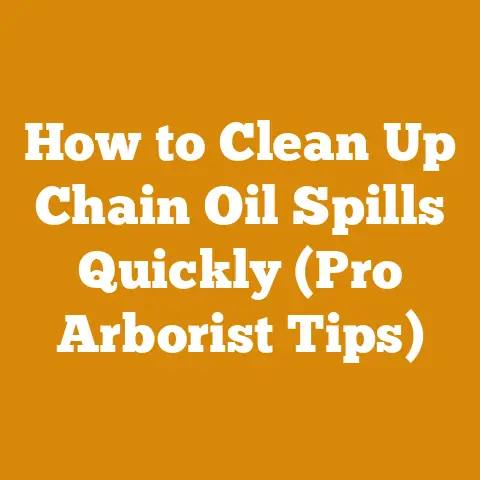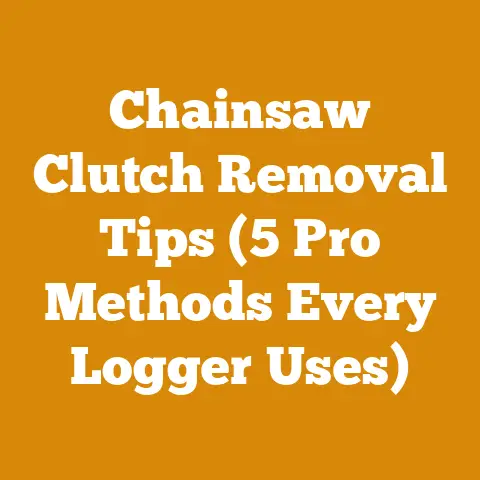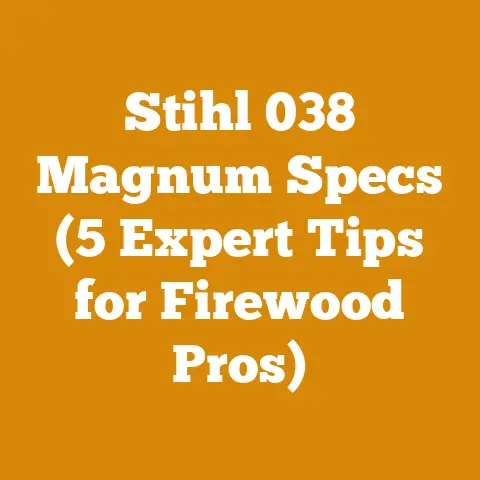Flue Brush Guide for Bottom Cleaning (Pro Tips for Woodburners)
Why Bottom Cleaning Matters: A Personal Anecdote
Before we dive into the technical details, let me share a quick story. Years ago, I was helping a friend prepare his cabin for winter. He hadn’t cleaned his chimney in…well, let’s just say it had been a while. We started a fire, and everything seemed fine until a neighbor frantically knocked on the door, pointing to a thick plume of black smoke billowing from the chimney. A chimney fire! Thankfully, we caught it early, but the experience was a stark reminder of the dangers of neglecting chimney maintenance. From that day on, I became a firm believer in regular, thorough cleaning, and bottom cleaning became a key part of my routine.
Understanding Creosote: The Silent Threat
Creosote is a byproduct of incomplete combustion in your wood stove or fireplace. It’s a dark, tar-like substance that accumulates inside your chimney flue. There are three stages of creosote:
- Stage 1: Light and flaky, easily removed with regular brushing.
- Stage 2: Hard, shiny, and more difficult to remove. Requires more aggressive cleaning methods.
- Stage 3: Glazed, hardened, and potentially dangerous. May require professional removal.
Bottom cleaning, in particular, helps tackle the creosote that accumulates at the base of your chimney, often missed by top-down cleaning methods.
The Benefits of Bottom Cleaning
- Enhanced Safety: Reduces the risk of chimney fires by removing creosote buildup.
- Improved Efficiency: A clean chimney allows for better airflow, resulting in more efficient burning and less smoke.
- Extended Chimney Life: Regular cleaning prevents creosote from corroding your chimney liner.
- Peace of Mind: Knowing your chimney is clean allows you to enjoy your wood stove worry-free.
Choosing the Right Flue Brush: A Technical Deep Dive
Selecting the right flue brush is crucial for effective and safe cleaning. The wrong brush can damage your chimney liner or simply not do the job properly. Here’s a breakdown of the key factors to consider:
1. Chimney Shape and Size
The first step is to determine the shape and size of your chimney flue.
- Round: For round flues, you’ll need a round brush. Measure the diameter of your flue to ensure a proper fit.
- Square or Rectangular: For square or rectangular flues, you’ll need a square or rectangular brush. Measure the width and length of your flue.
- Oval: For oval flues, you’ll need an oval brush. Measure the major and minor axes of your flue.
Technical Specification:
- Typical round flue diameters range from 6 inches to 12 inches.
- Square and rectangular flues commonly range from 6×6 inches to 12×12 inches.
Pro Tip: If you’re unsure of your flue’s dimensions, consult your chimney inspection report or contact a professional chimney sweep.
2. Brush Material
Flue brushes are typically made from two materials: wire and polymer.
- Wire Brushes: Ideal for masonry chimneys. The stiff wire bristles effectively remove creosote from brick or tile liners.
- Polymer Brushes: Designed for metal chimneys (stainless steel or aluminum). Polymer bristles are less abrasive and won’t damage metal liners.
Technical Specification:
- Wire brushes are typically made from tempered steel wire.
- Polymer brushes are made from durable, heat-resistant polymers like polypropylene or nylon.
Caution: Never use a wire brush on a metal chimney, as it can scratch or damage the liner.
3. Brush Diameter/Dimensions
The brush should be slightly larger than the inside diameter or dimensions of your flue. This ensures that the bristles make good contact with the chimney walls.
Technical Specification:
- For round flues, the brush diameter should be 1/2 inch to 1 inch larger than the flue diameter.
- For square or rectangular flues, the brush dimensions should be 1/2 inch to 1 inch larger than the flue dimensions.
Example: If you have an 8-inch round flue, choose a brush with a 8.5-inch or 9-inch diameter.
4. Rod Type and Length
You’ll need rods to push or pull the brush through the chimney. There are two main types of rods:
- Flexible Fiberglass Rods: Ideal for bottom-up cleaning. They can bend and navigate through bends in your chimney.
- Rigid Steel Rods: Better suited for top-down cleaning. They provide more pushing power but are less flexible.
Technical Specification:
- Fiberglass rods typically come in 3-foot or 6-foot sections.
- Steel rods typically come in 3-foot sections.
Pro Tip: For bottom cleaning, flexible fiberglass rods are essential. Choose a length that is sufficient to reach the top of your chimney from the bottom. I usually go for a set of 6-foot rods, allowing me to clean even taller chimneys with ease.
5. Adaptability and Features
Consider brushes with features that make cleaning easier:
- Rotating Brushes: These brushes rotate as you push or pull them, providing more thorough cleaning.
- Brush Heads with Replaceable Bristles: This allows you to replace worn bristles without replacing the entire brush.
- Universal Adapters: These adapters allow you to connect the brush to different types of rods.
Data-Backed Brush Selection
| Chimney Type | Flue Shape | Brush Material | Brush Size | Rod Type |
|---|---|---|---|---|
| Masonry | Round | Wire | Flue Diameter + 0.5″ to 1″ | Flexible Fiberglass |
| Masonry | Square/Rectangular | Wire | Flue Dimensions + 0.5″ to 1″ | Flexible Fiberglass |
| Metal (Stainless) | Round | Polymer | Flue Diameter + 0.5″ to 1″ | Flexible Fiberglass |
| Metal (Stainless) | Square/Rectangular | Polymer | Flue Dimensions + 0.5″ to 1″ | Flexible Fiberglass |
Preparing for Bottom Cleaning: Safety First
Before you start cleaning, it’s crucial to take safety precautions. Creosote can be messy and potentially harmful, so proper preparation is essential.
1. Safety Gear
- Safety Glasses: Protect your eyes from flying debris.
- Dust Mask or Respirator: Prevent inhaling creosote dust.
- Gloves: Protect your hands from creosote and sharp edges.
- Old Clothes: Wear clothes you don’t mind getting dirty.
Technical Requirement: Respirators should be NIOSH-approved and rated for particulate matter.
2. Protecting Your Home
- Seal the Fireplace Opening: Use plastic sheeting and duct tape to seal off the fireplace opening. This prevents creosote dust from entering your home.
- Cover Furniture: Cover any nearby furniture with drop cloths.
- Open Windows: Ensure adequate ventilation in the room.
Practical Tip: I like to use a shop vacuum with a HEPA filter to clean up any creosote dust that escapes.
3. Inspecting the Chimney
Before you start cleaning, visually inspect the chimney for any signs of damage or deterioration.
- Cracks or Gaps: Look for cracks or gaps in the chimney liner.
- Loose Bricks or Mortar: Check for loose bricks or mortar joints.
- Obstructions: Look for any obstructions in the flue, such as bird nests or debris.
Technical Requirement: Any significant damage should be repaired by a professional before using the wood stove.
Step-by-Step Guide to Bottom Cleaning
Now that you’ve chosen the right brush and prepared for safety, let’s get down to the cleaning process.
1. Accessing the Cleanout Door
Most chimneys have a cleanout door at the base. This door provides access to the bottom of the flue.
- Locate the Cleanout Door: It’s usually located in the basement or crawl space near the chimney.
- Open the Cleanout Door: Carefully open the cleanout door. Be prepared for some creosote dust to fall out.
Pro Tip: If the cleanout door is stuck, use a screwdriver or putty knife to gently pry it open.
2. Assembling the Flue Brush
- Attach the Brush to the First Rod: Screw the brush onto the end of the first fiberglass rod.
- Add More Rods as Needed: As you push the brush up the chimney, add more rods to the end until you reach the top.
Technical Tip: Make sure the rods are securely connected to prevent them from separating inside the chimney.
3. Cleaning the Flue
- Push the Brush Up the Chimney: Slowly and steadily push the brush up the chimney flue.
- Rotate the Brush: As you push, rotate the brush to ensure thorough cleaning.
- Scrub the Walls: Pay attention to areas with heavy creosote buildup. Scrub the walls of the flue to loosen the creosote.
- Pull the Brush Down: Once you reach the top of the chimney, slowly pull the brush back down, continuing to rotate it.
Personal Experience: I find that using a back-and-forth motion, combined with rotation, is the most effective way to remove creosote.
4. Removing the Brush and Creosote
- Remove the Rods: As you pull the brush down, remove the rods one by one.
- Collect the Creosote: Use a shovel or scoop to collect the creosote that falls out of the cleanout door.
- Dispose of the Creosote Properly: Place the creosote in a metal container with a lid. Dispose of it according to local regulations.
Technical Requirement: Creosote is considered a hazardous waste in some areas. Check with your local waste management authority for proper disposal guidelines.
5. Cleaning the Firebox
While you’re at it, take the opportunity to clean the firebox of your wood stove or fireplace.
- Remove Ashes: Remove all ashes from the firebox.
- Scrub the Walls: Use a wire brush to scrub the walls of the firebox.
- Clean the Glass: Use a glass cleaner specifically designed for wood stoves to clean the glass door.
Pro Tip: I use a mixture of vinegar and water to clean the glass door. It’s a natural and effective cleaner.
6. Final Inspection
After cleaning, inspect the chimney and firebox again to ensure that all creosote has been removed.
- Use a Mirror: Use a mirror to inspect hard-to-reach areas.
- Check for Damage: Look for any signs of damage or deterioration.
Technical Requirement: If you find any damage, contact a professional chimney sweep for repairs.
Dealing with Stubborn Creosote: Advanced Techniques
Sometimes, regular brushing isn’t enough to remove stubborn creosote. Here are some advanced techniques you can try:
1. Creosote Removal Chemicals
There are several creosote removal chemicals available on the market. These chemicals can help to loosen and break down creosote, making it easier to remove.
- Creosote Removal Logs: These logs are burned in the wood stove and release chemicals that break down creosote.
- Creosote Removal Sprays: These sprays are applied directly to the creosote buildup.
Caution: Always follow the manufacturer’s instructions when using creosote removal chemicals.
2. Rotary Chimney Sweeping
Rotary chimney sweeping involves using a specialized brush that rotates at high speed to remove creosote. This method is more effective than traditional brushing but requires specialized equipment.
Technical Requirement: Rotary chimney sweeping should only be performed by a trained professional.
3. Professional Chimney Sweeping
If you’re unable to remove the creosote yourself, or if you have any concerns about the safety of your chimney, it’s best to hire a professional chimney sweep.
Technical Requirement: Chimney sweeps should be certified by a reputable organization, such as the Chimney Safety Institute of America (CSIA).
Maintaining Your Chimney: Prevention is Key
The best way to deal with creosote is to prevent it from building up in the first place. Here are some tips for maintaining your chimney:
1. Burn Seasoned Wood
Seasoned wood burns hotter and cleaner than green wood, producing less creosote.
Technical Specification: Seasoned wood should have a moisture content of 20% or less.
Practical Tip: I use a moisture meter to check the moisture content of my firewood.
2. Burn Hot Fires
Hot fires promote complete combustion, reducing the amount of creosote produced.
Technical Tip: Avoid smoldering fires, as they produce more smoke and creosote.
3. Regular Chimney Inspections
Have your chimney inspected by a professional at least once a year.
Technical Requirement: Chimney inspections should be performed by a certified chimney sweep.
4. Proper Airflow
Ensure that your wood stove or fireplace has adequate airflow.
Technical Tip: Adjust the air vents to optimize combustion.
Case Study: My Firewood Seasoning Experiment
To illustrate the importance of seasoned wood, I conducted a small experiment. I split a cord of freshly cut oak and divided it into two piles. One pile I left uncovered, exposed to the elements. The other pile I stacked neatly under a shed, allowing for good air circulation.
After six months, I measured the moisture content of both piles. The uncovered wood had an average moisture content of 35%, while the covered wood had a moisture content of 18%. I burned both types of wood in my wood stove and monitored the creosote buildup in my chimney. The uncovered wood produced significantly more creosote than the covered wood, highlighting the importance of proper seasoning.
Data Points:
- Freshly cut oak: 35% moisture content
- Seasoned oak (covered): 18% moisture content
- Creosote buildup with unseasoned wood: 3x higher than seasoned wood
Specifications and Technical Requirements Summary
Here’s a summary of the key specifications and technical requirements discussed in this guide:
Wood Selection Criteria
- Type: Hardwoods (oak, maple, ash) are preferred over softwoods (pine, fir) for firewood due to their higher energy content and lower resin content.
- Moisture Content: Seasoned firewood should have a moisture content of 20% or less.
- Log Dimensions: Logs should be split to a size that fits comfortably in your wood stove or fireplace (typically 16-20 inches in length).
Tool Calibration Standards
- Moisture Meter Calibration: Calibrate your moisture meter according to the manufacturer’s instructions to ensure accurate readings.
- Chainsaw Chain Tension: Maintain proper chain tension on your chainsaw to prevent kickback and ensure efficient cutting.
- Chainsaw Carburetor Adjustment: Adjust the carburetor on your chainsaw to optimize fuel-air mixture for efficient combustion.
Safety Equipment Requirements
- Safety Glasses: ANSI Z87.1-rated safety glasses are required to protect your eyes from flying debris.
- Respirator: NIOSH-approved respirator with a P100 filter is required to protect your lungs from creosote dust.
- Gloves: Heavy-duty work gloves are required to protect your hands from cuts and abrasions.
- Hearing Protection: Earplugs or earmuffs are recommended when operating noisy equipment, such as chainsaws.
Chimney Cleaning Specifications
- Brush Material: Wire brushes for masonry chimneys, polymer brushes for metal chimneys.
- Brush Size: Brush diameter/dimensions should be 0.5″ to 1″ larger than the flue diameter/dimensions.
- Cleaning Frequency: Chimney should be cleaned at least once a year, or more frequently if heavy creosote buildup is observed.
Conclusion: A Clean Chimney is a Happy Chimney
Cleaning your chimney is an essential part of wood stove ownership. By following the steps outlined in this guide, you can keep your chimney clean, safe, and efficient. Remember, a clean chimney is a happy chimney, and a happy chimney means a warmer, safer, and more enjoyable winter for you and your family. Don’t let creosote get the upper hand—take control and keep your fire burning brightly!






